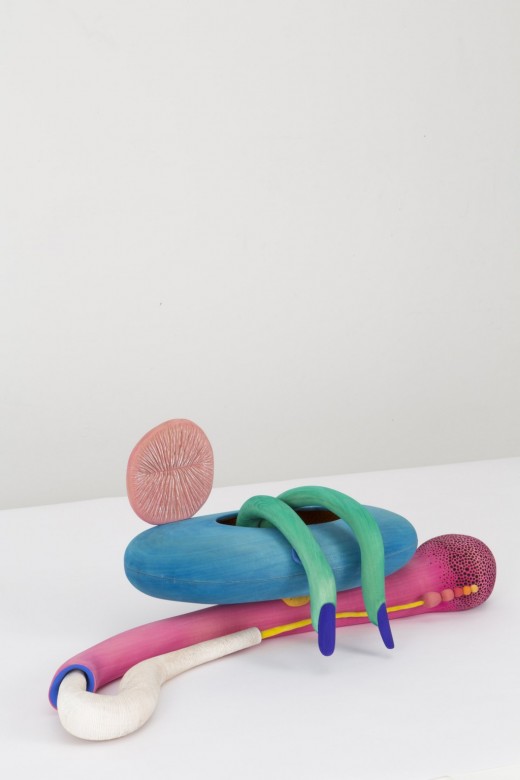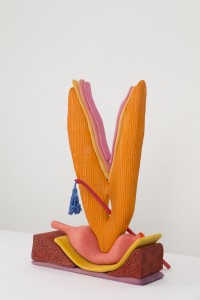MATTHEW RONAY: When Two Are In One
Martha Raoli

For at least a decade, Ronay’s work has responded to what happens when one thing passes through another, and the site of this passage is the orifice. These responses have taken the form of drawing, costumery, performance, sculpture, installation, and life-size dioramas. The artist’s long-established relationships with Andrea Rosen Gallery, New York, and Nils Stark, Copenhagen, have produced numerous shows, and more recent exhibitions include the 12th Lyon Biennial, as well as shows with Marc Foxx, Los Angeles, and Marlborough Chelsea. No stranger to Miami, in 2011 Ronay and Nathan Carter were invited by Locust Projects to create a site-specific installation that, according to director Chana Budgazad Sheldon, “included handmade costumes, stage sets, and musical instruments based on misunderstandings of both Mummenschanz (a Swiss mime troupe started in the 1970s) and early Bauhaus performances . . . to a packed room of enthusiasts.”
Though I’m sure to embarrass him by saying so, you might say Ronay makes devotional art. In the studio, he practices labor with the intention of a monk or Shaker, looking for illumination in the shapes of things. He works to enter a meditative state, from which he can source imaginative forms from his own private pantheon. That these shapes also resound with our own collective semiotics is testament to the claim that good art, art that matters to us, must serve the creator first.
He is one of the rare artists who has passed thought the MFA vortex of insular theory and come out through the other end with the earnest sensibility of a folk artist. He’s a woodworker whose handsy constructions recall the earthy muscle of California clay tradition; any superficial resemblances to the oozing bubbles of Kenneth Price and the drippy sheen of Ron Nagle’s little sculptures only pronounce the differences in materiality and production. This is wood worked by hand.
Each sculpture begins as one solid block of wood that is chiseled, carved, and cut into parts, shaped, and reassembled. There’s poetry in how they fit; sensuality lies in the joints. An elegant example of how constituent parts are reassembled into one form is Cairn Column Wand (2015). A primordial signal for travelers, a cairn marks a site, lets you know you are on the right path, and acts as an existential marker of having been there. Is there a more substantial role for sculpture than this? Cairn Column Wand is a vertical pile of triangles and spheres, some perfectly stout and others smashed thin as pancakes, stacked one over another, over another. Achieved by the simple act of piling, the cairn, a terrifically humble apparatus, succeeds if it remains erect and doesn’t topple. As for the wand of the title, its tip ends in a flourish, which I suspect holds the magic (sometimes a star, here reduced to a triangle), an apex that somehow suggests a fulcrum. The idea of balance is so much a part of the piece, and one might imagine an invisible horizontal line balancing on its tip. Other forms evoked are totem, Christmas tree with a topper, spear, skewer—I prefer these last two, because they also express the action that provokes the form. To stack, to skewer, to spear, to pile.
Cairn Column Wand may best express how Ronay is at work with his choice material, basswood. The material doesn’t perform like wood. Instead it recalls, by its shape and behavior, scalped rubber balls, silly putty pounded with a fist, curved soapstone, or bean-shaped slabs of coral reef. The way the patty-cake disks drape on each other with biomorphic awkwardness does not feel like something wood does organically. Ronay works the wood so it appears to take on the physical qualities of soft organisms, revealing woodworking so attuned to the empirical realities of the material that is has tapped into its impossibilities. You get the sense that wood has been gently willed into theatrical postures while being perfectly honest about its texture—the grain lines accented by pastel stains. Different shades and hues help distinguish the character of each piece, and it can’t be overlooked how pleasingly the palette of bubble-gum pink and ocean blue and pumice gray and cobalt Klein-like blue activate the eye up, down, up, and down looking for matches, gradients, familiar prismatic relationships, searching for associations between colors and shape that leave you endlessly skimming for a resolution to an inscrutible pattern.
The title of the work Probe (2015) likely refers to the fanciful red wand that pierces the sculpture’s hole, but it also signals formal investigations, the probing for shapes through the excavation of the wood. A slim whip lends a slight BDSM vibe. The tip of this wand sprouts a dangling beaded tassel that invokes both sperm and the flashy bait of flyfishing lures and mating feathers. Supporting the wand is a superstructure V padded by tongues and lips lining the mouth and all manner of fleshy pads and mattresses as the baseline. Cradling the inverted nub is an aortic whoopee cushion that looks comfy and fits snugly. The V, it should be noted, looks content. Could blue beads at the end of a wand be the smoke from a cigarette?
The sly Progeny (2015) alludes to another result of sexual union, the new human. Two alluringly grotesque, groovy green fingers slink over the rim of an aquamarine oval hollow, an egg, a decoy tomb, a womb. A finely puckered pink coin rises like an anal sun. There’s fun to be had in pronouncing these shapes, while straining to recognize the real just beyond the reach of representation. Is the pink bulb riddled with holes a microphone or a rattlesnake? The fingers themselves appear to be reptilian, slithering menacingly from ominous nether regions. All this is mounted on snaking tubes, each one swallowed in progression by its larger encasement the way our blood vessels are encased and telecommunication lines are bundled.

Matthew Ronay, Cairn Column Wand, 2015. Basswood, plastic, dye, flocking, and shellac-based primer, 109.2 x 25.4 x 25.4 cm. Courtesy the artist and Andrea Rosen Gallery, New York; Marc Foxx, Los Angeles; and Nils Stærk, Copenhagen
Joyfully, Ronay’s language can be accessed without a museum brochure. Though reminiscent of the talismans and prayer artifacts of this or that ideology, there is no set of privileged cultural symbols at play. As such, these quasi-ceremonial totems resist cultural hegemony. While When Two Are In One finds resonance with the culturally diverse ethos of the museum, its placement within the more didactic interests of the institution is complex. Through Aboriginal Australian abstract painting or the museum’s ongoing permanent collection exhibition, Global Positioning Systems, PAMM seeks to “illuminate the role of place and location as central to the conception of itinerant identity,” to quote the introduction to the recent group show Poetics of Relation. Ronay’s work isn’t framed by geo-locational or anthropological clues. It’s precisely this rich encoding that excited Diana Nawi, associate curator, who said, “because the visual, cultural, formal, and aesthetic references in the work are so myriad they defy us to locate or trace them all, and ultimately this ‘referentiality’ is only part of what I consider Matthew’s very singular approach.”
This installation in the gallery adjacent to PAMM’s lobby teases the audience to presume it represents an elusive foreign culture. In fact, the works belong to all cultures, and as such, transcend ideologies. They can be activated with absolutely no prior or supplementary knowledge of either Ronay’s personal identity politics, his ancestral culture, or any vernacular tradition of his native land. The work resists the illustrative or educational roles of art making. This is one of those projects—like Geoffrey Farmer’s delightful Let’s Make the Water Turn Black (2013–14), on view at PAMM last year, that belongs to anyone, and in fact, for this reason perfectly illuminates the mission of the museum, as Nawi confirms. “His work is certainly informed by an incredible openness to a global art history—across geographies and temporalities—and he very smartly and self-consciously engages that conversation, and he is comfortable with certain processes, influences, and aesthetics that defy a lot of dominant conversations in contemporary art, which is where I might locate the resonance of his practice with PAMM’s broader program.”

Matthew Ronay, Probe, 2015. Basswood, plastic, steel, dye, and gouache, 88.9 x 66 x 35.6 cm
Martha Raoli is a writer and artist living in Miami.









